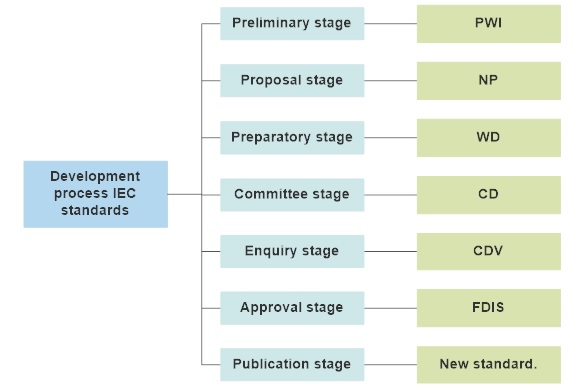In the previous “standards section” it was discussed in broad steps how a standard, organization technically comes into being. This article explains how the content of a standard is determined, collected and adjusted to a final internationally accepted document. The IEC standards described here are compiled by volunteers from all over the world (including members of our association) and are based on consensus. The development process consists of 7 steps:
Process step Result recorded in:

Preliminary stage
Proposed work item (PWI)
The Preliminary stage includes proposals/ideas for possible projects that may be implemented in the future but are not yet ready for immediate development.
The preliminary phase is used for work items for which target dates cannot yet be set and/or information is still limited. This phase in the development process is used to elaborate a new work item proposal and develop an initial concept. These work items are carried out, subject to approval, according to standard procedures before proceeding to the proposal phase.
Proposal stage
New work item Proposal (NP)
A proposal for a new standard usually comes from the industry via a National Committee and is submitted to the members of the relevant Technical Committee (TC) that manages the field. For example TC101 Electrostatics or TC77 Electromagnetic compatibility. A new proposal is approved and will be continued if:
a 2/3 majority of the P-members (voting members of the Member States, including us) of the relevant committee agree with the proposal and sufficient experts are nominated (at least 4) to work out the proposal (including members of our association). Now that the proposal has been approved, the preparation of the document begins
Preparation stage
Working Draft (WD)
During this phase a working document is drawn up, usually by a project leader within an international project team. This working document is the basis for the new standard
In this phase the first details and ideas are collected such as measurement methods, required measurement values and measurement conditions and circulated a number of times between the project team members for additions and improvements
This phase ends when the submitted data has been processed into the working document and is ready for distribution to the members of the technical committee, which from then on is called a committee draft (CD) and is now registered/monitored in the IEC systems.
Committee stage
Committee draft (CD)
At this point, the document is submitted to the National Committees for comment as a Committee Draft (CD). This remains available for up to 12 months.
The committee stage is the main stage where comments from national committees are taken into account, with a view to reaching consensus on the technical content. National Committees will therefore carefully examine the texts of committee drafts and submit all relevant comments at this stage. How
The next newsletter will discuss how comments from Member States, including ours, are collected and processed.
(By Bas Grootemaat Kingsize Consultancy)
Related companies

